Most new crypto enthusiasts try to make money with crypto by finding a coin that they hope rallies by 100x, making them a gazillionaire. However, in most cases, that's a mug's game. There is a more stable way of making gains, and that is staking.
Proof-of-stake (PoS) is considered one of the best alternatives to proof-of-work (PoW). And there are now many projects that use this consensus algorithm and allow their users to earn some juicy staking returns.
So, what are the best coins to stake?
In this post, we will look at the top 7 best staking coins, give you an in-depth overview of the proof-of-stake (PoS) consensus, and share top tips to help you make the most from staking your coins.
Proof of Stake at Work
When Bitcoin launched in 2009, the consensus algorithm chosen to secure the network was a proof-of-work (PoW) algorithm.
Two years later, in 2011, the proof-of-stake (PoS) consensus algorithm was introduced on the Bitcointalk forum to avoid the problems associated with the proof-of-work (PoW) algorithm. Most importantly, the focus was on changing the heavy usage of resources needed to perform mining and reach a consensus.
Proof-of-stake (PoS) took a significantly different path to reach consensus.
The proof-of-work (PoW) algorithm uses computational resources to solve cryptographic problems to secure the network and validate blocks. By comparison, the proof-of-stake (PoS) algorithm uses an election process, with coin holders selecting the node to validate each block. It's an excellent way to help secure the network.
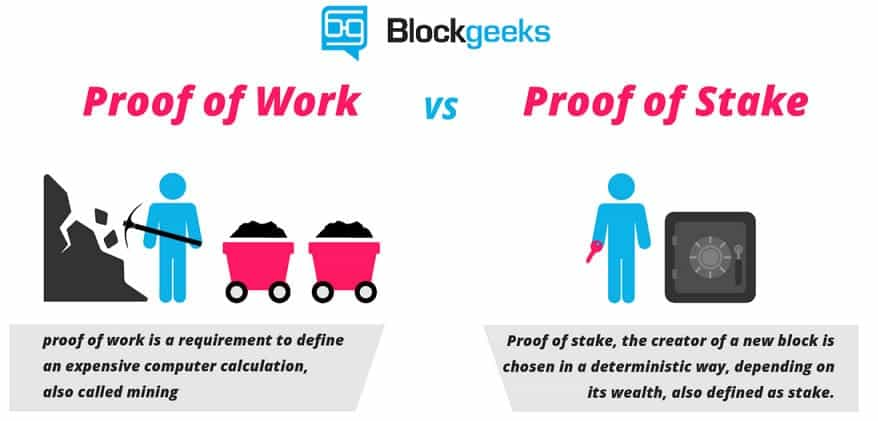
Proof-of-work (PoW) and proof-of-stake (PoS) systems vastly differ in creating cryptocurrencies and incentivising and rewarding individuals. For example, proof-of-work (PoW) blockchains like Bitcoin reward their miners with newly created cryptocurrency as part of the mining process. For example, Bitcoin Miners receive Bitcoin (BTC) as rewards.
In the case of proof-of-stake (PoS) blockchains, the stakers are typically rewarded using transaction fees.
Another significant difference is that the blocks on proof-of-stake (PoS) systems are "forged" rather than being "mined" like in Proof of Work systems. Many proof-of-stake systems begin as proof-of-work and later switch, such as Ethereum, while others will get their start by selling a stash of pre-mined coins.
How Staking Works
Users interested in participating in the forging process on a proof-of-stake (PoS) blockchain can do so by locking a predefined amount of coins as their stake. The size of the stake determines whether an individual is selected to validate and forge the next block. Individuals with a larger stake have a greater chance of becoming the next to validate a block and receive a reward.
Whenever a node is selected to forge a block, it begins by checking each transaction to determine if they are valid. If they are, the node generates the block and adds it to the blockchain. In return, the node receives the transaction fees associated with that block as a reward.

Several unique variations on the basic Proof of Stake algorithm have been added to this process to avoid the wealthiest nodes being favoured consistently in the selection process. Two of these methods are Coin Age Selection and Randomized Block Selection.
Coin Age Selection
This method chooses validating nodes depending on how long coins were staked. The staked coins are multiplied by the length of time held to determine the coin age.
After forging a block, the coin age resets to zero. The reason is to establish that a determined time passes before reusing those coins.
This method also prevents nodes with large stakes from controlling the blockchain.
Randomized Block Selection
In this method, the selection isn't as random as you might think based on the name. The validating node is selected by searching for nodes with the largest stake and the lowest hash value. Because blockchains make each address's holdings public, including the stake size, it is usually possible to forecast the next forger based on available information.
Many different cryptocurrencies use the proof-of-stake (PoS) method. Each has unique techniques and rules for validating and forging new blocks, typically created by what developers decide is best for the blockchain and its users.
Why Use Staking?
The stake in the proof-of-stake (PoS) system is a financial incentive for node operators. It helps to ensure that nodes will not validate fraudulent transactions and assists in securing the network.
PoS works because when a network detects a fraudulent transaction, the node that forged it loses part of its stake and cannot generate blocks in the future. If the stake remains higher than the forging reward, the validating node will lose more by forging fraudulent transactions.
Proof-of-stake is a secure system because a node must own a stake equal to 51% or more of all staked coins to gain control of the network and freely approve fraudulent transactions.
In nearly every case, this is impractical, if not impossible, given the considerable value of most blockchains. Imagine trying to control 51% of the circulating supply of a cryptocurrency with a market capitalisation of $1 billion.
As you can see from this point, the primary advantages of using the proof-of-stake (PoS) algorithm are energy or resource efficiency and blockchain security.
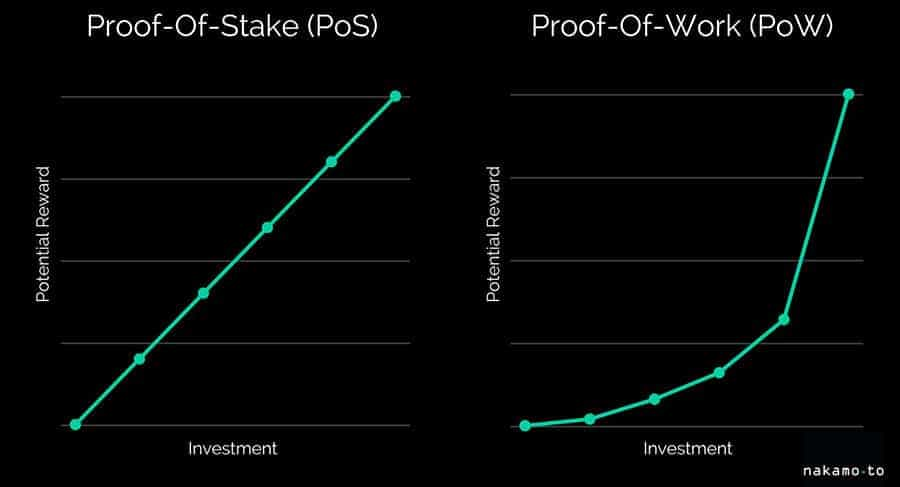
This consensus encourages users to set up their nodes. Additionally, the small forging reward and decreased need for releasing large amounts of coins as a reward can help to stabilise the price of any particular proof-of-stake (PoS) cryptocurrency.
In the case of staking, the coins are locked in a wallet. Over time, nodes receive rewards, adding more coins to their wallet. The more coins held, the greater the staking rewards. It's comparable to getting bond interest payments or dividend payouts.
Passive Income Through Cryptocurrency?
There are many different coins available for staking. For example, the website StakingRewards.com has over 200 yield-bearing digital assets listed. Some of the most popular cryptocurrencies are proof-of-stake (PoS) coins, including Ethereum (ETH), Solana (SOL), Cardano (ADA) and Tezos (XTZ).
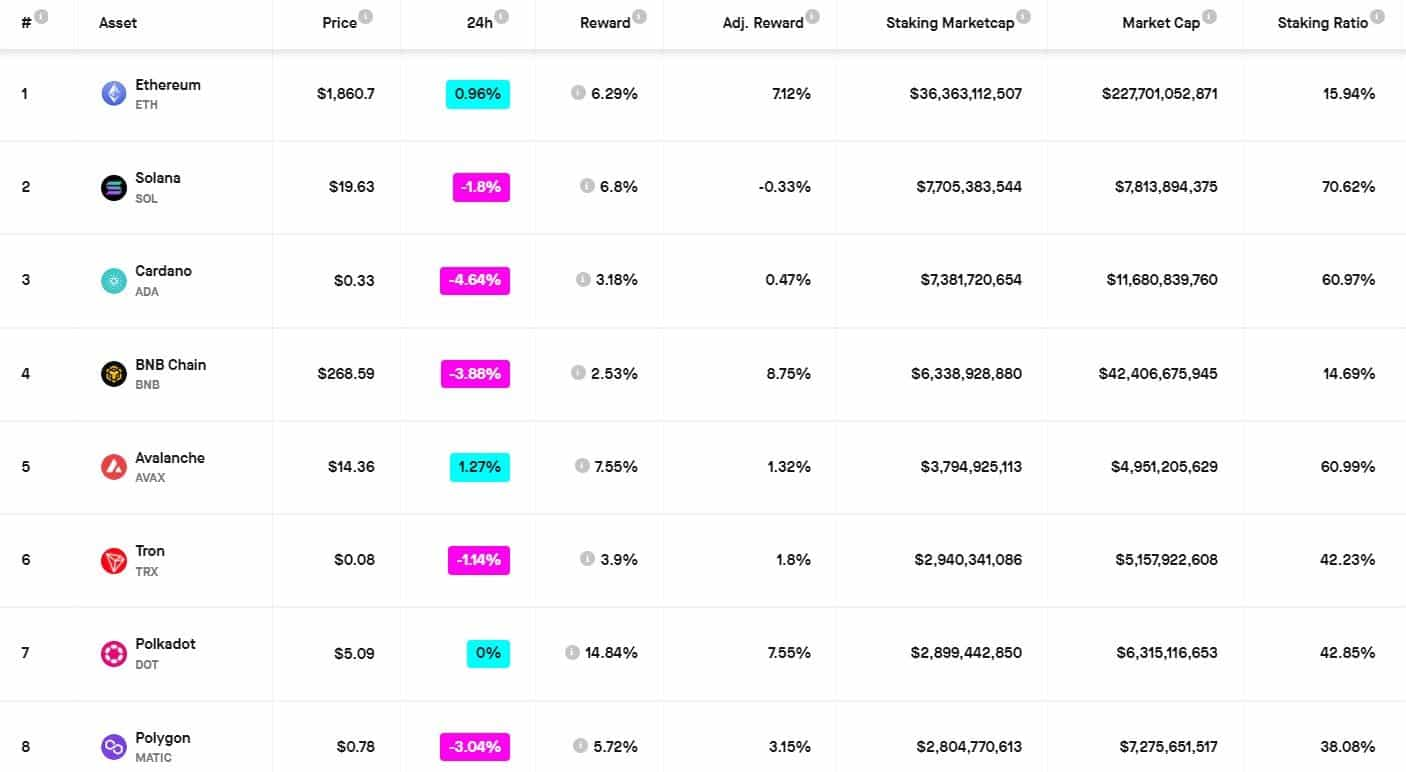
Holding your coins in an exchange wallet and continuing staking is possible in several cases. Tezos allows users to hold XTZ in a Binance or Coinbase wallet and still stake those coins. The downside is that the exchange keeps a percentage of the rewards generated through staking.
Staking can be a way to increase cryptocurrency holdings with little effort and expense. The danger is that some projects have done things that inflate the projected return from staking, which means it isn't as profitable to stake certain coins as the project would have you believe. We always recommend that you research a project's economic models for staking to ensure it is effective and sustainable.
After that, research communities and understand the general feeling about the blockchain involved.
Top 7 Staking Coins
So, you now have a basic understanding of staking coins, so let's carry on to discover our top picks for the 7 best staking coins.
We based the criteria for the following coins on several factors:-
- Coins with a decent staking return
- Established blockchains with a good reputation
- Ease of staking
Take your time deciding which coin best suits your staking needs.
1. Tezos (XTZ)
Tezos (XTZ) launched on June 30, 2018, and the mainnet went live in September of the same year. It was first proposed in a 2014 whitepaper by husband and wife team Kathleen and Arthur Breitmana whilst working at Morgan Stanley.
Tezos is an open-source platform that supports Turing complete smart contracts and DApps. The design of the protocol that runs Tezos was to be self-correcting, and the platform looks to use an on-chain governance model to manage changes to the network.
Tezos was created using the OCaml programming language and is unique. It also implements a unique delegated proof-of-stake (PoS) consensus called liquid-proof-of-stake (PoS) (LPoS).
"A blockchain designed to evolve. Security focused. Upgradeable. Built to last." (Source: Tezos)
XTZ, Tezos native cryptocurrency, powers the blockchain using a process called "baking", which is a different spin on the word "staking." The process is the same. Balers receive rewards for staking their XTZ to help validate new blocks.
Users must deposit a minimum of 6,000 XTZ if they wish to become a node operator. However, they can own part of that stake and receive some from delegators instead of trying to raise the required XTZ alone. In return, the third-party baker takes anywhere from 0% to 25% of the staking rewards. Yield rates vary from 4.98% annually
"Seamlessly, Forklessly, Endlessly Upgradeable." (Source: Tezos)
Where to Buy Tezos (XTZ)
Most of the leading cryptocurrency exchanges list Tezos XTZ for buying and staking, including: -
- Binance
- Coinbase Exchange
- Kraken
- Bitfinex
What Wallet Can You Use for Storing Tezos (XTZ)?
Multiple wallets support Tezos XTZ, such as the following: -
- AirGap (software wallet)
- Trust Wallet (software wallet)
- Atomex (software wallet)
- Ledger and Trezor (hardware wallets)
Tezos (XTZ) is listed in the top sixty cryptocurrencies on CoinMarketCap.
For a full list of suitable wallets, visit the Tezos website or read our in-depth review.
2. Ethereum (ETH)
Ethereum (ETH) is the second largest cryptocurrency by market capitalisation (over $220 billion). Vitalik Buterin first described Ethereum in a 2013 whitepaper. In 2014, Buterin and other co-founders raised funding for the project via a public crowd sale, raising over $18 million in Bitcoin (BTC).
Ethereum is a layer-1, decentralised open-source blockchain system, and the native cryptocurrency is Ether. Ethereum is best known as a platform for many other cryptocurrencies to build upon and execute decentralised smart contracts.
Ethereum has more developers than any other blockchain, reportedly over 5,000 in January 2023. The network has over 9,000 nodes across the globe, helping to secure the network and validate transactions. (Source: Ethereum)
Ethereum began as a proof-of-work (PoW) consensus mechanism but transitioned to proof-of-stake (PoS) in September 2022. Ethereum has received criticism for high gas fees (which can run into hundreds of dollars) and slow transaction speeds (30 TPS). Still, Ethereum has a solid and loyal community that believes in the project, and many, many layer-2 blockchains continue to build on Ethereum.
Ethereum is committed to improving its shortfalls. The roadmap outlines future upgrades to improve: -
- Cheaper transactions
- Extra security
- A better user experience
- Future-proofing measures
"Ethereum is a technology that's home to digital money, global payments, and applications. The community has built a booming digital economy, bold new ways for creators to earn online, and so much more. It's open to everyone, wherever you are in the world – all you need is the internet." (Source: Ethereum)
Where to Buy Ethereum (ETH)
Cryptocurrency exchanges worldwide list Ethereum (ETH) because it is the second listed cryptocurrency. Always select a reputable and established platform, such as: -
What Wallet Can You Use for Storing Ethereum (ETH)?
You can choose from a vast range of suitable and secure wallets that store Ethereum (ETH
- MetaMask (online wallet)
- Trust Wallet (software wallet)
- Guarda Wallet (software wallet)
- Ledger and Trezor (hardware wallets)
Ethereum is the number two listed cryptocurrency on CoinMarketCap.
To learn more, read the Ethereum 101 article.
3. Cardano (ADA)
Charles Hoskinson (co-founder of the Ethereum network) founded Cardano in 2017.
The blockchain was named after Gerolamo Cardano, a 16th-century Italian polymath. It was the first blockchain developed with evidence-based methods and peer-review research.
"Making the world work better for all: Cardano is a blockchain platform for changemakers, innovators, and visionaries, with the tools and technologies required to create possibility for the many, as well as the few, and bring about positive global change." (Source: Cardano)
Cardano (ADA) has multiple use-cases. The website lists the following: -
- Education: Credential Verification: Cardano built an ID and credentials solution (Atala PRISM) on the blockchain.
- Finance: Onboarding: Atala PRISM is also a credential verification solution for the finance industry.
- Retail: Product Counterfeiting: Cardano created a tamper-proof system (for product provenance (Atala SCAN) to help prevent the counterfeiting problems in the retail industry.
- Health: Counterfeit Medicine: Atala SCAN is also available for the health industry to ensure the authenticity and origin of pharmaceutical products, "guaranteeing the safety and well-being of patients worldwide."
- Agriculture: Supply Chain Tracking: Cardano created a solution to keeping a supply chain moving (Atala TRACE) from "farm to table" in the agricultural industry.
- Digital Identity: Government: A digital identity solution Atala PRISM) that leverages blockchain technology so that users have "full control of their credentials." PRISM enables users to instantly verify and share their credentials anywhere at any time.
ADA is Cardano's native cryptocurrency used as a store of value. ADA was named after a 19th-century mathematician, and computer programmer, Ada Lovelace. The token is a secure store of value for a variety of services and applications. Users can stake Cardano (ADA) and earn rewards by delegating to a stake pool.
"A History of Impossible, Made Possible." (Source: Cardano)
Where to Buy Cardano (ADA)
Cardano (ADA) is available with most of the leading, established cryptocurrency exchanges.
What Wallet Can You Use for Storing Cardano (ADA)?
There are dozens of secure wallets that support storing your Cardano (ADA). The below are a few examples: -
- Exodus (Multichain Web3 wallet)
- Daedalus Wallet (Full-node desktop wallet)
- Yoroi (Mobile wallet)
- Ledger and Trezor (hardware wallets)
Cardano (ADA) is listed in the top ten cryptocurrencies with CoinMarketCap.
Read our 2024 Cardano review for an in-depth exploration of this popular blockchain.
4. Loom Network (LOOM)
The Loom Network launched in 2018 as a Platform as a Service (PaaS) blockchain allowing Solidity-based DApps to run on side chains. The reasoning behind the creation of this system is that each application should be able to use an appropriate consensus model based on individual needs and potential threats.
The Loom Network uses delegated-proof-of-stake (DPoS) to enable the scaling of DApps while keeping them on the Ethereum blockchain for its security. Staking didn't become available on the network until February 2019
The Basechain is a high-performance side-chain that acts as a bridge between several different chains, including Ethereum, Bitcoin, Tron, Binance Chain, EOS, and Cosmos.
Loom Network's native token is LOOM, a proof-of-stake (PoS) token used to secure the Loom Network mainnet. Developers use LOOM to pay for dApp hosting, and users can stake it to receive rewards.
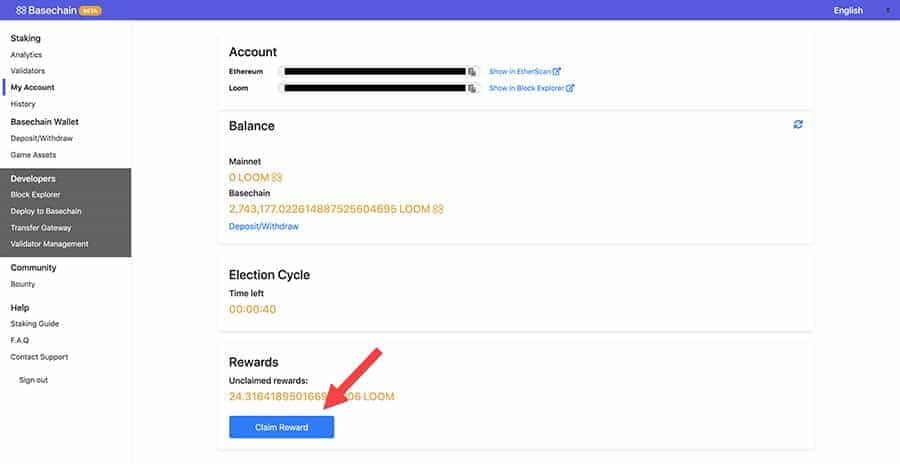
After that, users must connect to the LOOM Basechain Wallet to the wallet holding their LOOM tokens. Then you can transfer the LOOM tokens to the Basechain Wallet.
The next step is to delegate your LOOM tokens to a validator. The validators keep a portion (as much as 25%) of the staking rewards. Rewards will accumulate in the Basechain Wallet, and users must manually collect those rewards occasionally.
The good news for all these steps is the annual return on LOOM staking is variable depending on which platform you choose, from 5% up to 17%. That helps make LOOM staking a top pick.
“The Production-ready, Multichain Interop Platform for Serious DApp Developers.” (Source: Loom Network)
Where to Buy Loom Network (LOOM)
You won't find Loom Network (LOOM) listed on as many cryptocurrency exchanges as others in the top seven staking coins. However, you can still purchase from a reputable platform, such as: -
What Wallet Can You Use for Storing Loom Network (LOOM)?
There aren't as many wallets supporting LOOM as some of the other cryptocurrencies on our list. However, here are a few: -
• Trust Wallet (software wallet
• Ledger (hardware wallet)
• Coinbase Wallet
To learn more about the Loom Network (LOOM) read our in-depth review.
5. Polkadot (DOT)
Polkadot began in 2016, founded by Gavin Wood (Ethereum co-founder) and co-founders Robert Habermeier and Peter Czaban. It was the flagship protocol of the Swiss Web3 Foundation with a mission to create an open-source, decentralised and user-friendly web.
Polkadot has a unique protocol that connects and secures networks of specialised blockchains. It enables interoperability between blockchains as the protocol facilitates cross-chain transfers of data, asset types, and crypto tokens.
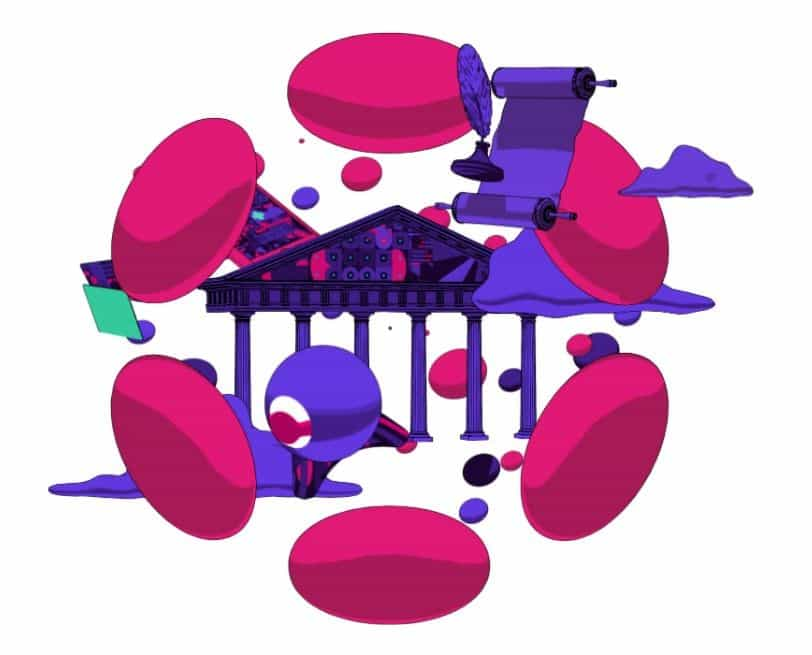
Polkadot is a layer-0 metaprotocol because it provides a foundation for layer-1 blockchains. This technology is known as parachains (parallel chains). It is a unique blockchain because it can forklessly and autonomously update its codebase with on-chain governance through the decisions made by the Polkadot token holders in its community.
Polkadot can connect private and public chains, oracles, potential future technologies and permissionless networks. Via the Polkadot Relay Chain, blockchains can share transactions and information trustlessly.
DOT is Polkadot's native token, used for: -
• Staking: Helping operations and security on the network.
• Network Governance: Token holders have the right to vote on decisions.
• Bonding tokens to connect the parachains.
"Polkadot unites and secures a growing ecosystem of specialized blockchains called parachains. Apps and services on Polkadot can securely communicate across chains, forming the basis for a truly interoperable decentralized web." (Source: Polkadot)
Polkadot has four unique components: -
1. Relay Chain: Helps with consensus, interoperability, and shared security across a network of chains.
2. Parachains: Independent chains with their own tokens for optimising clear use cases.
3. Parathreads: Not dissimilar from parachains, but parathreads have flexible connectivity using a pay-as-you-go model.
4. Bridges: A "link" for connecting parathreads and parachains for connecting and communicating with other blockchains, Ethereum, for example.
Where Can I Buy Polkadot (DOT)
Polkadot (DOT) is available at most of the leading reputable exchanges.
What Wallet Can You Use for Storing Polkadot (DOT)?
Polkadot has a range of wallets, including some built by the Polkadot community.
- Polkawallet
- Encrypt Wallet
- Fearless Wallet
- Ledger (hardware wallet)
Polkadot (DOT) is a popular cryptocurrency, listed in the top fifteen by CoinMarketCap. If you'd like to learn more about it, read our in-depth Polkadot review.
6. Cosmos (ATOM)
Cosmos (ATOM) calls itself the most customisable, scalable, powerful and interoperable ecosystem of connected blockchains. It's a decentralised network of independent blockchains powered by Tendermint and other Byzantine Fault Tolerant algorithms (technology that allows a blockchain to achieve consensus even in an environment that potentially contains malicious nodes).
Cosmos strives to become the "Internet of Blockchains" by linking the myriad of blockchains into a single network where tokens can transfer seamlessly throughout the network.
Cosmos uses a Delegated Proof of Stake (DPoS) system in which there are delegators (aka stakers) and validators. The delegators decide which validators will participate in consensus, and the validators work to validate transactions and add new blocks to the blockchain.
Both groups can collect staking rewards, paid in ATOM tokens, but theoretically, you could use any token added to the network from any blockchain
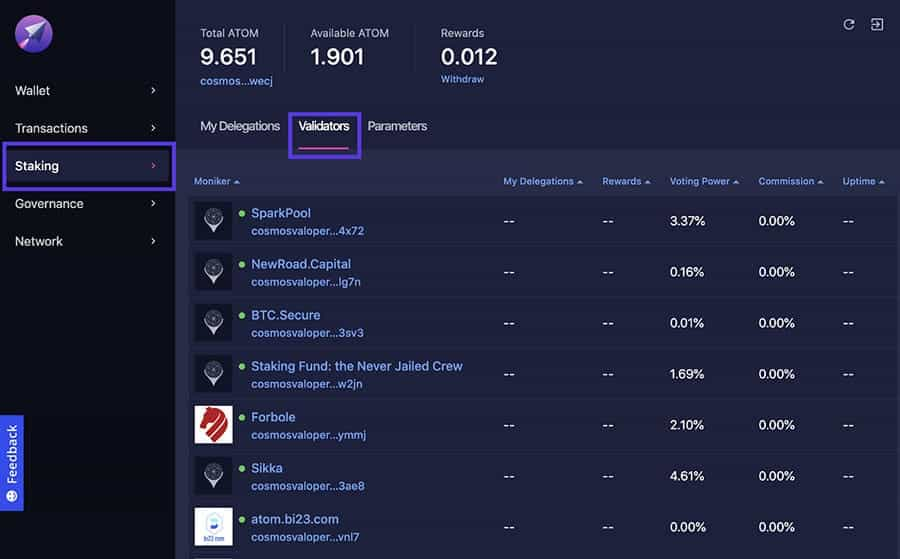
Staking rewards at the time of writing are 8.2% annually but can go as high as 20% if the proportion of ATOM staked falls below two-thirds of the total supply. Staking is as easy as holding ATOM in a supported wallet and then choosing a validator to delegate to. It is also necessary to periodically claim rewards manually.
Cosmos remains a popular project, and ATOM is currently ranked in the top twenty-five listed cryptocurrencies by market capitalisation.
"Build on the Interchain. Build a blockchain using the best-in-class open-source libraries and services." (Source: Cosmos)
The staking rewards for the token are excellent. If the team can successfully implement its vision for an "Internet of Blockchains", it could begin paying staking rewards in several cryptocurrencies, putting it ahead of other projects.
Where to Buy Cosmos (ATOM)
Cosmos (ATOM) is available from the leading reputable cryptocurrency exchanges, such as: -
What Wallet Can You Use for Storing Cosmos (ATOM)?
You have a good choice of wallets for storing ATOM, including the following: -
- Trust Wallet (software wallet)
- Exodus (Multichain Web3 wallet)
- Guarda Wallet (software wallet)
- Ledger (hardware wallet)
Cosmos (ATOM) is in the top twenty listed cryptocurrencies on CoinMarketCap.
To learn more about Cosmos, read our in-depth review.
7. NEAR Protocol (NEAR)
NEAR Protocol is a layer-1 blockchain founded in 2017 by software developers Alexander Skidanov and Illia Poloshukin. After that, NEAR Protocol bought together fifty experienced developers from across the globe to form the NEAR Collective.
The NEAR Protocol mainnet launched in April 2020 with 1 billion NEAR tokens created.
NEAR is a community-run platform with unique scaling solutions (a problem for many blockchains). The NEAR Protocol differs from other blockchains as it does not use cryptographic wallet addresses. Instead, it uses easily readable account names.
"The OS for an open web: Effortlessly create and distribute innovative decentralized apps across any blockchain, while helping build a more open web, with the NEAR Blockchain Operating System (BOS)." (Source: NEAR Protocol)
NEAR is a delegated-proof-of-stake (DPoS) blockchain. It uses a block generation process called "Doomslug" and "Nightshade", a sharding mechanism that can process more than 100,000 transactions per second (TPS). Subsequently, transaction fees are super low.
NEAR is the native cryptocurrency for the NEAR Protocol blockchain, used for staking by network validators (nodes) and delegators. The blockchain burns NEAR tokens regularly to pay network fees.
NEAR Protocol (NEAR) is in the top fifty listed cryptocurrencies on CoinMarketCap.
Where to Buy NEAR Protocol (NEAR)
Near Protocol (NEAR) is available on most of the leading cryptocurrency exchanges.
What Wallet Can You Use for Storing NEAR Protocol (NEAR)?
Near Protocol (NEAR) has a secure wallet of it's own, or you can choose from a selection of other wallets.
- Near Wallet
- Guarda Wallet (software wallet)
- Ledger (hardware wallet)
- Trust Wallet (software wallet)
"Trusted by web3's most innovative teams." (Source: NEAR Protocol)
NEAR Protocol (NEAR) is in the top forty listed cryptocurrencies on CoinMarketCap.
Read our in-depth review to learn more about the NEAR Protocol (NEAR).
Summary of Average Staking Returns: Top 7 Cryptos
We recommend checking up-to-date staking returns for yourself before staking your coins.
| Asset | Reward Average | Staking Marketcap | Marketcap |
| Ethereum (ETH) | 6.2% | $36B+ | $223.5B+ |
| Cardano (ADA) | 3.1% | $7.3B + | $11.8B+ |
| Polkadot (DOT) | 14.8% | $2.8B+ | $6B+ |
| Cosmos (ATOM) | 20.9% | $2.8B+ | $3.4B+ |
| Tezos (XTZ) | 4.79% | $594M+ | $818.8M+ |
| NEAR Protocol (NEAR) | 8.09% | $771M+ | $1.3B+ |
| Loom Network (XTZ) | 4.0% | Unknown | $51M+ |
Data From Staking Rewards
Top Staking Coins: Conclusion
Many excellent coins are available for staking, and we've only touched on a few of the best. There are many other staking coins to explore, and this is by no means a comprehensive list. However, remember to do your homework and not stake a random token just because you like the name or your best mate suggests it's a good idea.
Remember, when choosing a coin, base your decision on factors like: -
- You can buy from an established, reputable cryptocurrency exchange.
- The blockchain has good utility and is (ideally) in the top 20-30 listed cryptocurrencies by market capitalisation.
- Reputable, secure and easy-to-use crypto wallets support the coin.
- You understand how to stake and the period of "lock-in" involved.
- You accept that all financial decisions have risk attached, and nothing is guaranteed.
If the entire staking process twists your brain like a pretzel, you might consider staking coins with an exchange like Binance, which does most of the work for you as they act as the delegator. It's as simple as holding the coins in a Binance wallet and assigning them to a staking pool.
Of course, these services are not free. Whilst we appreciate all businesses need to make money, exchanges charge a fee that could eat into your staking returns. Check these fees before committing to the easy option.
Another consideration is the risk of a potential trade-off when allowing an exchange to manage your staking activity. A decentralised project could become centralised if the larger platforms gain the majority control of the staking pools.
Either way, adding some of these coins to your portfolio can help to even out potential volatility in coin prices. If you plan to HODL your coins, why not make some income from them while waiting for the crypto market to improve? It provides a way to create a passive income stream while being more stable than crypto trading.
Frequently Asked Questions
It depends on what you hope to get from staking cryptocurrencies. For example, if you already have cryptos in a secure wallet doing nothing, it makes sense to stake them and earn a yield. However, it must always be your choice and take advice from a financial expert
As advised in the article, rather than choosing a random coin that isn't proven and established, it is best to select a crypto for staking that has history and a good reputation. Even if that means you might make a little less than the 40% offered by a “Ponzi” coin, it is considered less risky.
Good advice is never to invest more than you can afford and take financial advice before making a decision.
Yes, in many jurisdictions, gains from staking is subject to tax. Always check the financial regulations in your country for the best advice on managing your staking income.
It might help to read best crypto tax software: Top 7 tax tools for crypto.
Every crypto has a different percentage for staking. You can get an updated overview of all the available staking tokens and yield percentages from Stakingrewards.
Your earning also depend on how much you invest in staking cryptos.
Disclaimer: These are the writer’s opinions and should not be considered investment advice. Readers should do their own research.

